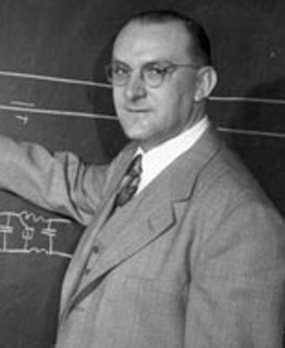Oscar Herbert Schmitt:
How he has transformed the scene
FM Radio, the ball-point pen, chocolate chip cookies….and the Schmitt Trigger
You may be a loyal "Mac person" or perhaps a die-hard "PC person," but without a handy invention called the Schmitt trigger, neither could communicate data at all. This electronic circuit, which allows a continuous electronic signal to be changed to an on/off state, is fundamental to all computers and many other electronics. It's hard to believe it was created by 21-year old grad student Otto Schmitt in the mid-1930s, long before the existence of computers. In fact, the Schmitt trigger was invented in the same decade as FM radio broadcasting, the ball-point pen and chocolate chip cookies.
Sparks of Inspiration Start Early
Schmitt was born in St. Louis, Missouri in 1913. His high intellect was clear from the start — he completed elementary school a semester early, started his studies at Washington University in St. Louis before finishing high school, and published his very first paper, "A Vacuum Tube Method of Temperature Control," during his freshman year of college at age 17.
As a young man, Schmitt's zest for invention often led to somewhat shocking results. There was the time eight-year-old Otto electrified the carcass of a rabbit that was meant to be the family's dinner, making the rabbit jump and giving the cook quite a jolt of surprise.
Another time, he created a homemade Tesla coil. He recalls the mischievous fun he had with his creation, which included his mother's dishpan, mason jars, a transformer he bought with his Christmas money and an Edison phonograph:
"Oh, boy, was that ever fun! Your hair stood on end, sparks a couple of inches long came out of your nose and ears and off the tips of your fingers. I demonstrated this to my pals, who turned out the lights to better see the sparks. My mother heard the roar of the spark gap and came in to investigate. When she opened the door and found me standing there surrounded by fire, she fainted dead away. I was in the doghouse for awhile, but at least I had my 200,000-volt Tesla coil."
From Minnesota to Top-Secret Military Work And Back Again
In 1939, Schmitt was working abroad on a fellowship in London when he was offered a position at the University of Minnesota as an instructor of zoology and physics. He accepted, and moved to Minnesota against the backdrop of World War II.
By 1941, the U.S. officially entered the war. And Schmitt, a member of the "Greatest Generation," was asked to join the National Defense Research Committee (NDRC), a newly formed federal organization conducting top-secret scientific research with military applications. He put his own research on the backburner and took a leave of absence from the University to focus on antisubmarine warfare research.
At that time, German U-boats were repeatedly attacking American ships, and the need to locate these submerged Nazi threats was increasingly urgent. Within one month of joining the NDRC, Schmitt developed a working prototype of the Magnetic Anomaly Detector, or MAD System, which identified small abnormalities in the Earth's magnetic field — like those created by large steel submarines. The MAD System pinpointed the location of enemy submarines, and dramatically reduced the number of successful attacks by German U-boats.
Schmitt's full accomplishments from his time with the NDRC are veiled in secrecy, but it is known that he made additional wartime contributions to flight simulation training, radio communications for high-speed aircraft and the ability to jam enemy signals. He returned to the University of Minnesota in 1947, remaining there as a professor of biophysics, bioengineering and electrical engineering until his retirement in 1983.
Finding Inspiration in the Natural World
Throughout his remarkable career, Schmitt earned Ph.Ds in physics, mathematics and zoology. He was awarded more than 60 patents, authored over 270 publications and founded the University of Minnesota's Biophysics lab. His work also received an impressive array of awards and honors, including his election to the National Academy of Engineering in 1979 and dual awards from the Institute of Electrical and Electronics Engineers (IEEE) in 1987 with the Centennial Medal and Lifetime Achievement Award.
Schmitt, who was referred to as an "intellectual heavyweight" by his peers, also developed the concept of biomimetrics— the mimicry of nature — which studies nature's models and then replicates these designs to create processes and solutions for human problems.
In fact, Schmitt's most famous invention, the Schmitt trigger, was a direct result of his study of squid nerves. He was one of the country's top authorities on biophysics and bioengineering, and his work greatly shaped electronics, heath care, and medical technology. Schmitt's biographer, Jon Harkness, wrote, "Viewing his life in full context suggests that the Schmitt trigger was a mere prelude to his greatest innovation, which Schmitt fully articulated near the end of his career: the concept of a biomimetric approach to science and engineering — an idea rather than a gadget."
Schmitt passed away in 1998 at age 84, four years after the death of his beloved wife, Viola.

